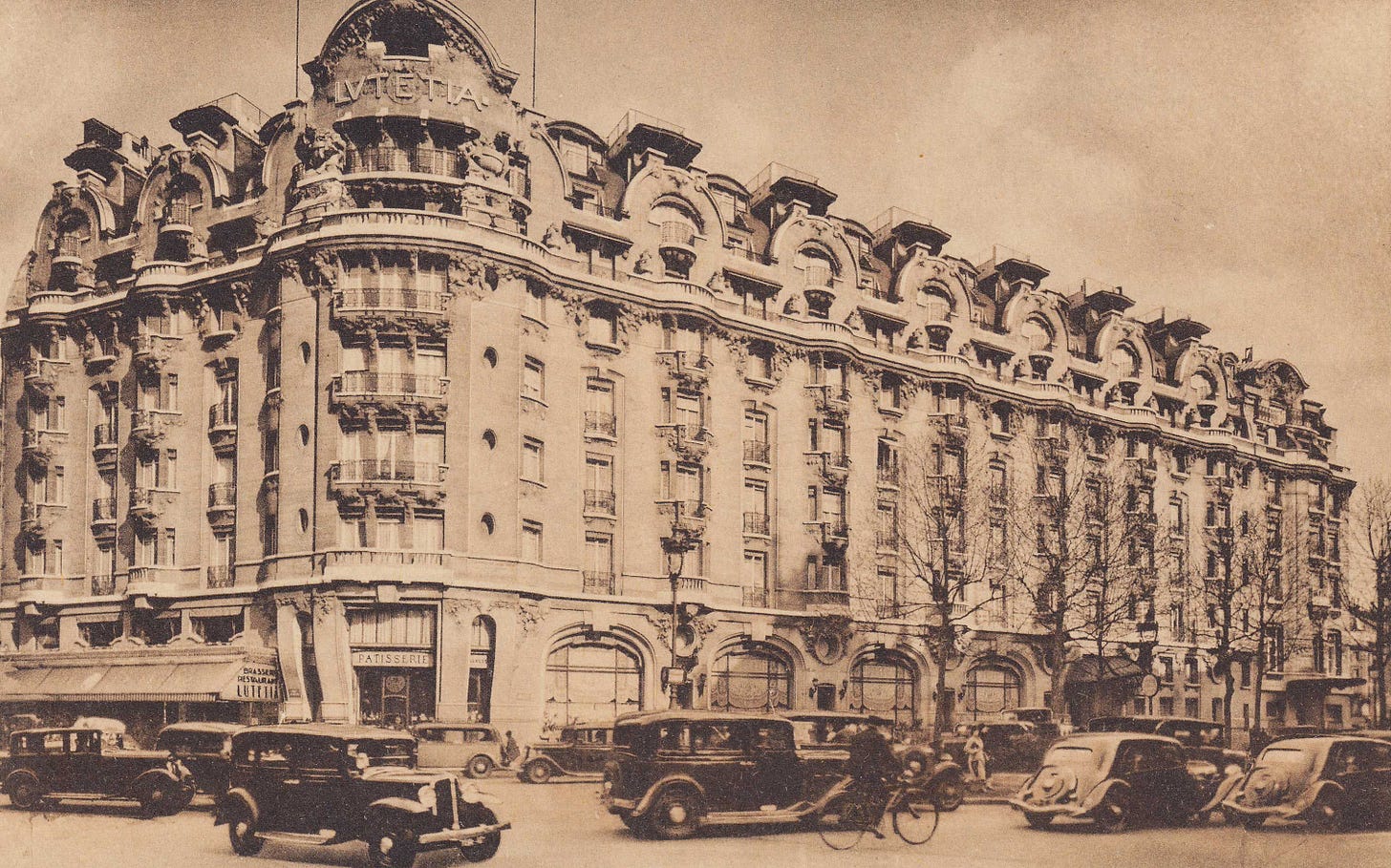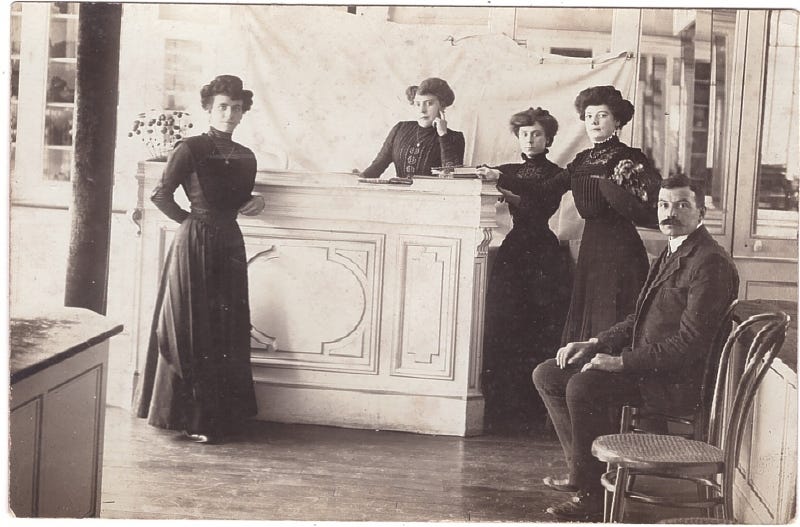Let me tell you a story. The story of a remarquable couple that shaped the future of commerce: Marguerite and Aristide Boucicaut. These two are the founders of Le Bon Marché, the oldest and most iconic shopping temple in the world. If you somehow enjoy shopping, you owe these guys a lot.
After my recent visit, I wanted to dig deeper. Plus I easily fall in love with a good story of a couple / friends breaking the status quo - don’t ask me why.
Ready for a crazy life-long adventure? Read on.
aristide
It all begins in the little town of Bellême, Normandy, year 1810. Aristide is born in a milliner family, they make and sell hats. As a kid he works with his dad, before heading to Paris at 19 years old.


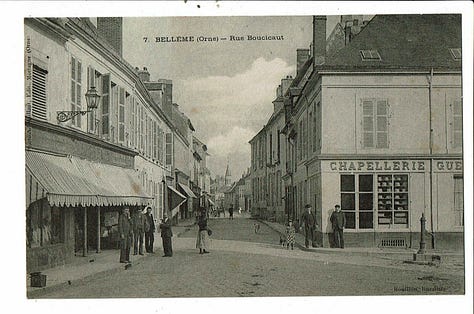
At 24, he’s hired as a young vendor at the Petit Saint Thomas, a magasin de nouveautés (~ novelty store) rue du Bac, in the 7th arrondissement of Paris. He’s sharp and trustworthy, and quickly becomes the purchasing manager of one of their 21 sections: the shawls.
Wait - what’s a magasin de nouveautés?
Before 1850, you’d purchase clothes and daily objects from :
peddler, carrying their baskets throughout the streets ;
fair merchants, carrying their goods from one village to another ;
storekeepers, offering a very restricted, specialised range of products inside a tiny store ;
dressmakers, coming to your place… if you could afford it.
These magasins de nouveautés were radically disruptive, for they offered:
fixed, displayed prices - no more bargaining ;
a free entrance for anyone - no more intimidating doors and forced purchases ;
a large range of products - no more entering five shops to buy five items ;
a store organised in sections (silk, lace,..) you could walk through, each one with its own counter and sales assistant.
OK this, is Aristide.
marguerite
Marguerite is born in 1816 in the tiny hamlet of Verjux. Her mom is a single-mother, not really a high status at the time, to say the least. Marguerite grows up in a shanty, working as a goose keeper, like her mom. At age 12, goose keeping is no longer allowed - gooses have to be parked inside pens. They’re out of business. She is illiterate, like most people in these very rural areas at the time. Now, she and her mom can’t make a living.

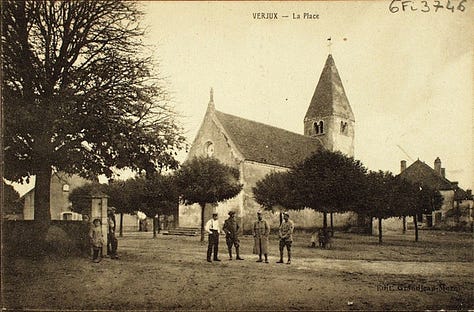
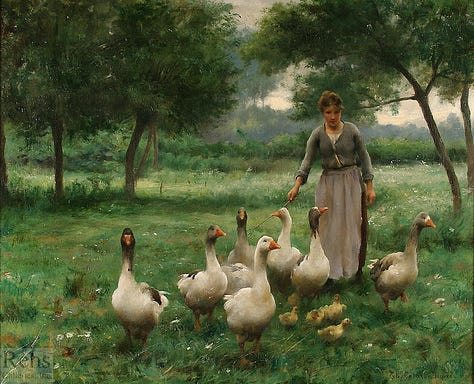
So her mom sends her to Paris, at her uncle’s. He is a water carrier, and Marguerite starts working as a laundress apprentice rue du Bac.


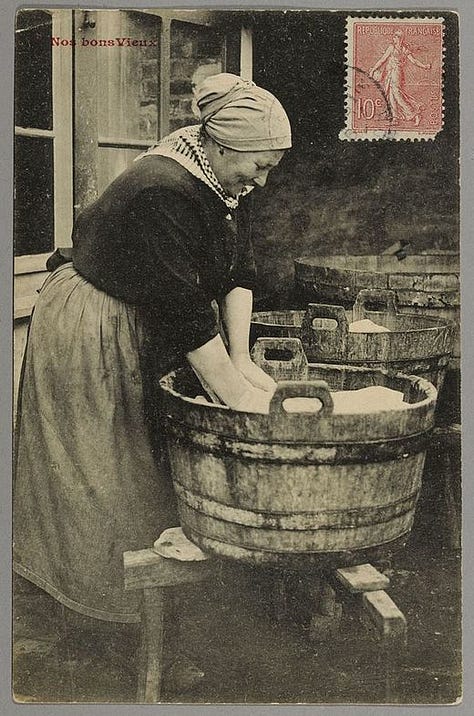
She quickly learns how to read and write. She also saves money to open her own “bouillon”, a cheap restaurant that serves one unique hot meal a day to workers in the neighbourhood.
Guess who’s coming for lunch, on a regular basis? Shawl-expert Aristide. ❤️ Of course.
wrong match?
1835. He is 25, she is 19. They start living together but are not allowed to get married, for Aristide’s family won’t accept he has fallen in love with a lower class woman. Their unique child, Anthony-Aristide, is born four years later.
fired, so what
1848. They finally get married, and that same year, our 38 years old Aristide loses his job at the Petit Saint Thomas: a new tax on these multiple-section stores gets the business on its knees. He then knocks at Au Bon Marché down the street, a decade-old magasin de nouveautés selling haberdashery, sheets, tablecloth, towels and umbrellas. Aristide joins this little team of 12 employees and rapidly seduces the owners, the Videau brothers, with his vision of modern commerce ; together, they implement some of the revolutionary techniques we mentioned earlier, like displaying clear fixed prices. This would build trust among their clientele and get the word out. Just four years in, the Videau brothers offer Aristide to become business partners. At 42, he brings along their couple savings and a recent heritage for a total of 50k francs (eq. to USD 240k today1).
all in
In a context of massive industrialisation - cheaper and larger production, railroad expansion - a new class is on the rise: the bourgeoisie. Aristide sees potential. He’s bullish on cutting margins (13.5% instead of the standard 41% in small retail) to renew the product offer at a higher pace (every 2 months instead of every 2 years). The Videau brothers freak out. In 1863, they sell the totality of their shares to Aristide and Marguerite for 1.5 millions francs (eq. to USD 5.6m today2). This financial move is made possible with the help of Henri Maillard - a french pastry chef who made his fortune in NYC - who lends the couple 2.2 millions francs (eq. to USD 8.2m today ; that they would pay back in just 7 years). Henri also shares valuable feedback about what’s working in NYC (e.g. low margin x high volumes). Respectively at age 53 and 47 years old, Aristide and Marguerite become the sole owners of Au Bon Marché.
let’s grow this, baby
A first wave of building extension works starts in 1869 (Haussmann style), then a second one in 1872, led by engineers Armand Moisant and Gustave Eiffel - rings a bell? This combination of a metallic structure and light wells throughout five floors and 52,000 sqm would provide natural light on the products all day long, all year long: genius.
Progressively, Au Bon Marché spreads across the whole block. The grand magasin is born. A magasin de nouveauté, just at a radically different scale.
Comfort is still a recent concept. Au Bon Marché, the bourgeoisie is given the permission to give comfort a try, then embrace it fully. Bourgeoisies are on the rise, and they should all afford its products: Au Bon Marché, one would soon be able to find just anything (not just textile), and in a large range of prices.
purchases made easy
mail order (1867), that quickly represents 15% of the revenue, is made possible through a catalogue of over 1500 products as well as fabric samples that get sent to the province and to other countries, spreading the influence of parisiennes beyond Paris
english speaking employees (1872)
seasonal sales (1873), and especially one that still runs today : Le Mois du Blanc (the White Month) in February, with incredible decorations and set up every year
concerts (1873) and conferences
free delivery
money-back guaranteed
amusements for the kids: theatre plays, donkey-back promenades in the square, balloons, collectible cards etc
blotting paper agenda (1880), yearly programs distributed to their customers : what’s not not miss, exceptional events, a Paris map (genius!) and cooking recipes
animated Christmas windows (1909)
even the Lutecia art deco palace hotel (1910) for their travelling customers - a wish from Marguerite
Marguerite and Aristide never stop innovating, and this goes way beyond sales techniques. They are crafting a place where people want to hang out, wander, be seen, socialise. And particularly women.
la Parisienne
Probably the most disruptive move of Marguerite and Aristide is this almost exclusive focus on women. At the time, women used to stay home and were not allowed to go anywhere on their own, except to church or the cemetery. Fun. (Remember that, next time you dream about the good old days) Fashion was brought to you by your dressmaker, who would visit you home, showing you a few designs and fabric samples. This is how you’d get dressed.
Things are about to change. Now women can spend their entire day Au Bon Marché: it is safe to wander and strut around. They can walk, take a look, touch, try on, read the newspaper, have a tea. Women discover their bodies and the pleasure to buy, that was still a man thing at the time. Shopping bags are delivered to your home so why would you need a man anymore? This is a true liberation for women. Aristide and Marguerite gave birth to La Parisienne.
In 1852, the sales assistants at the counters are all men. This proximity becomes unseemly. As one can imagine, Church doesn’t quite approve and makes a scandal. Far from taking a step back, Aristide and Marguerite, well, hire women to accompany their lady clients in their shopping experience. The Demoiselle de Magasin is born. This role is a true social promotion, something every low and middle class lady is dreaming about. They wear a black silk uniform and must behave in the most irreproachable way. Also, they are not allowed to sit. Ever.
empower and take care (paternalistic style)
Aristide and Marguerite Boucicaut were described as tough yet generous bosses. Way before any social law, they had already set up :
commissions for sales assistant (that double their basic income on average) ; incentives on the company’s net profit for purchasing managers (responsible for their own PnLs)
the 12-hour work day, instead of the standard 16-hour
canteens for the employees (distinct for men and women)
accommodations for the employees (distinct for men and women)
sales and english trainings - even a trip to London for the best students
annual leave (they only became mandatory in 1936)
free medical check up and an in-house doctor
medical insurance
contingency fund filled every year (after 20 years of loyal services though) based on the company’s net profit
retirement fund
give back
Of course, Au Bon Marché got copied : Le Louvre - 1855 ; Le Bazar de l’Hotel de Ville - 1856 ; Le Printemps - 1865 ; La Samaritaine - 1869 ; most of them launched by ex employees.
Aristide dies in 1877 at 67. Their son would outlive him two years but dies of a disease without having any kids. Marguerite still runs the business until she passes a decade later, at age 71. “The good lady of the Bon Marché” heads down her personal wealth to a public institution that would build the Boucicaut hospital (with 6 beds available at any time for the employees of the Bon Marché), to Louis Pasteur research work (rabies vaccine) and to her employees.
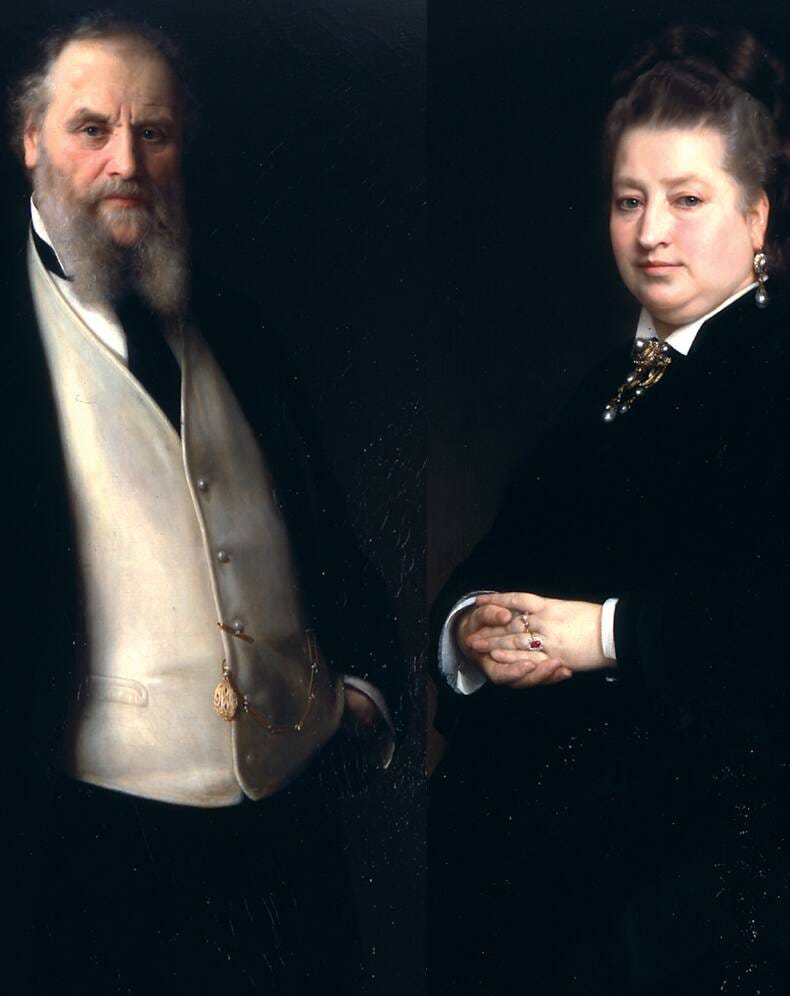
today
Decades 1920s and 1930s were flourishing with the rise of home appliances. Then the war. Then the rough competition of supermarkets.
In 1984, LVMH takes over. Au Bon Marché becomes Le Bon Marché. Most of these incredible innovations are still running today. In fact, it is impressive how nothing much has changed. Today, no less than 20 people are working daily to transform and enchant Le Bon Marché across seasons and festivities, curating product exclusivities:
Le Bon Marché hosts the largest wine cave in Paris, coachmen were replaced with parking valets, free delivery is on for the best customers, and there is apparently a top notch - and not so pricey - shoe care service in the basement. You’re welcome 😇
next
Fixed prices, huge variety of products, seasonal sales,… feels familiar? Isn’t it a little ironic that close to two hundred years down the road, nothing much has changed?
Marguerite and Aristide’s story is one of resilience and creativity. They were disrupters. Behavioural disrupters. Against all odds, they gave the bourgeoisie the permission to access comfort and status altogether, making their lives suddenly less miserable, desirable even, at scale: from Paris to the rest of the world.
And then 2024. A pendulum that went crazy on one direction: more, faster, cheaper.
What will the future of commerce be like? The mission of making people feel less miserable is very much a thing, still. Except in 2024, ‘feeling miserable’ is about being buried under stuff. Someone, something, needs to give people permission to live a less miserable life - and to gain status by doing so.
“The cathedral of modern commerce” as Zola wrote, might as well need a little sister.
Wait, who are you again?
If you’re new here, welcome 👋 We are Max, Kev and Mat. We’re building Objet, your “NEW CONSUMER” profile.
Objet is the french word for 'object' and should be pronounced 'ob-jeh‘. In this journal, we explore the intersection of desire, taste, joy, meaning and culture. If you’d like to embark on a journey with us, sign the manifesto 🫶
To dig deeper
I have gathered information from many reliable sources but won’t deny errors and omissions. Bear with me!
La Révolution Matérielle by Jean-Claude Daumas, a pure mine of information. Can’t thank you enough Tiphaine
for recommending this gem to me ;Au Bonheur des Dames (The Ladies’ Paradise) by Emile Zola, who at the time run a proper investigation among the Demoiselles de Magasin from the Bon Marché ;
Wikipédia : Le Bon Marché • Aristide Boucicaut • Marguerite Boucicaut ;
8 short videos (~30min total) by legendary Stephane Bern for Le Bon Marché ;
if you’re in a rush, just watch this (5min):
Always hit reply to send us a word, I love, we love reading you.
Good vibes and bisous.
Mathilde







